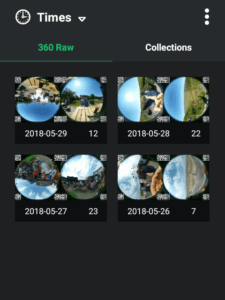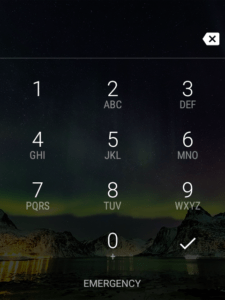Any links to online stores should be assumed to be affiliates. The company or PR agency provides all or most review samples. They have no control over my content, and I provide my honest opinion.
I have always been a big fan of Acer products; they make great laptops, monitors as well as the excellent Windows Mixed Reality Headset. They also like to dabble with other products and the most exciting product they have launched recently is the Acer Holo360, which is a 360-degree camera that is built around Android and the Snapdragon 625 SoC.
Priced at £299 it joins a growing trend of cameras focussed on 360-degree images and videos. Many of the options are add-ons to your phone that require you to plug it in via the USB/lightning port. A large number of the dedicated devices have no screen which then needs pairing with your phone or syncing with your PC before you can preview or edit the shots.
The Acer differs from the other options and is an all in one solution that is basically a 360-camera built around an Android smartphone.
The Holo360 runs on Android 7.1, includes a SIM card slot, has full WiFi and Android app compatibility, this gives it an extensive array of features that may not be available with competing products.
The full specification includes:
- OS – Android 7.1
- SoC – Qualcomm Snapdragon 625
- Display – 3-inch, 640 x 480
- Cameras – Two 16MP Panomorph camera lenses; 6.9K still images, 4K video; MP4 Format (H.265) f/2.1
- Networking – Bluetooth 4.1 + LE, 802.11ac, 3G/4G via SIM
- Battery – 2000 mAh
- USB – USB Micro-B
- Dimensions – 5.8 x 11.0 x 1.4 cm
- Weight – 139 g with battery
With its 3-inch display, this is considerably smaller than your normal phone but quite a bit thicker. The dimensions are more akin to a point and shoot camera, with it being around the same length as my Panasonic TZ60 but lightly less tall, and a little thinner. This makes it great for sliding into your pocket without adding too much bulk. Its petite size combined with Android does have some issues which I will cover later. Unlike my Panasonic, there is no camera mount point, which is not something I immediately thought I needed, but quickly learned it would have been handy.
The display is touchscreen just as you would expect with a phone and the low resolution is not too much of an issue on a screen this size, I was able to type in my login details during setup fine, though I wouldn’t want to type out a long email.
You get 4 hardware buttons which include 2 volume, a power and a capture image button. Then on the base of the phone is the microUSB and also a 3.5mm jack.
Set-up
If you have an Android phone, then you will be very familiar with the set-up process, this goes through the same settings as well as the ability to restore your cloud backup. This does mean the process is slower than setting up a regular point and shoot camera, but it easy and I was done within a few minutes. One of the options during the setup procedure is to use the camera in phone mode or camera mode. This option will customise the device to make it more camera orientated. In phone mode, it is just like a normal phone, and you have access to the Play store with all its apps.
You can also option download the Acer Live360 which will allow you to connect your main phone with the Holo360 and do live 360-degree streaming.
Interface and usability
The camera mode is heavily skinned to make it a bit more user-friendly with a limited number of apps shown on display. If you have set up an account and chosen to use a pin, you will need to unlock the camera each time you use it. This can become quite annoying, and if I didn’t have to send it back, I think I would reset it up with a new email address and leave it permanently unlocked.
It has several apps pre-installed, this includes things like Google mail so during use I was getting email notifications on my camera which may be useful for some people but I ended up stopping my emails account syncing with the device.
While Google mail was a bit annoying, having Google Photos on my camera is fantastic. I didn’t bother to use a sim card in the device, but whenever I had a WiFi connection the photos would automatically sync to my account.
The camera app is quite basic compared to some of the high-end phones I have used recently, unlike the Mate 10 Pro, there are limited shooting modes and no pro mode. You can choose to select a 360-image, wide-angle or a standard image. Within the settings, you can change the resolution of phones and video, apply a grid, change the storage location and a few other standard options.
I have never used a 360-camera before so it was surprisingly more work than your typical point and shoot, or your smartphone. The first thing I quickly realised is with it being a 360-camera, it captures everything, therefore if you are holding the camera you will get your arm and hand in the way at some point in the photos. To some extent this also applies to the wide angle shot too, you have to be quite careful about your hand placement to avoid fingers being in the image. My firsts day’s use had fingers in every shot!
Due to the dimensions of the camera, it is quite challenging to get a shot without getting your fingers in the way, you need to pinch the camera and carefully tap the shot button onscreen on the button on the side.
There are 2 ways to avoid this problem. Set the timer and use a selfie stick/mount. You will still get the mount in the picture, but it looks less silly than your arm and hand. Unfortunately, as I didn’t factor in this issue I didn’t have a mount that could hold a phone available for most of my review. I just have a screw in mount, hence why it would have been nice if this works with the Holo360. I did borrow a mount for my last day and this made things much easier with better quality images.
With the 360 images, the photos are stored in their raw format, which looks like two fisheye images next to each other than a bunch of QR codes. When you click on the image within the gallery app, the Holo360 will process the photo and give you the 360 image. From here you can process the image in 360 form, or you can choose the current view on the screen and export it as a fisheye view. If you have taken a lot of 360 shots during the day, you can bulk process them, but due to the processing time needed it limits this to 10 shots at a time.
When you export the shot as a fisheye image, you can manipulate what is shown on the shot and create some fun arty shots. It is a fun feature, and with the images being circular and therefore fitting in a square, they are the perfect dimension for Instagram or profile images. Alternatively, I used the popular 360-degree photo website Kuula to upload my photos, and from here you can select little planet mode to display all the content in a surreal planet shaped format.
During use, I did find the Holo360 can be frustrating to use at times with the Android OS at its base. I had to unlock the camera, go into the app and select what mode I wanted. It wasn’t uncommon for me to hit the back button and then have to re-navigate back into the app. Having all the functionality of Android makes things less usable if you need to take a photo quickly.
Performance and Sample Images
I should point out that my camera skills are sub-par and due to no mount, my arm is in a lot of the images, so my sample shots may not do the camera justice. Overall though, I found it too good at taking 360 shots but a bit of a mixed bag with the other shooting modes.
The wide-angle shots look great initially, but then I noticed on a lot of them there is distortion on the wider parts of the shot. I am not sure if this is a limitation of the wide-angle lens or more likely user error. I upped the resolution, and the issue was less apparent for the couple of shots I took on my final day of testing. With the standard format shots, it is not so much that the images were bad, its just they were not as good as my phone.
The 360 and fisheye images do much better. I particularity like the fisheye option and love being able to adjust the image to include different parts of the shot. Again, upping the resolution from the default setting of 4K to 6K produced better quality shots which I only did on the last day of testing.
Overall
I don’t have any frame of reference for 360-cameras, so I can’t compare the performance of this to others. From my use, it does the advertised job well and in a compact format that offers more features than several competing brands.
I found it a fun camera to use, and I can certainly see the appeal in a world obsessed with selfies and social media. This is perfect to post 360-images to Facebook, or fisheye shots to Instagram. Using Kuula, you can also save your 360 images in tiny planet form which is great for Instagram.
There are some caveats though, as a traditional camera it is not as good as my phone, so spending £299 on a device just for 360 images may seem extravagant for some people. All the functionality Android brings introduces some usability issues, unlocking my camera was particularly annoying for me. Then you also need a mount to take the best shots, but this will also apply to any other 360-camera.
While I have not reviewed other 360 cameras, if you are planning on getting one, this is a compelling option due to the all in one nature. It is priced in the upper-middle of the options available but as far as I can tell there are no affordable options available that have a screen and can do all the functions independently without you pairing a phone. The lower priced options generally have much lower resolution cameras too, with the Samsung Gear 360 using two 8.4MP cameras compared the two 16MP cameras the Acer uses.
You can buy the Acer Holo 360 Action Camera today from Acer for £299
Acer Holo360 Camera Review
Overall
80%-
Features - 85%85%
-
Performance - 80%80%
-
Price - 75%75%
I am James, a UK-based tech enthusiast and the Editor and Owner of Mighty Gadget, which I’ve proudly run since 2007. Passionate about all things technology, my expertise spans from computers and networking to mobile, wearables, and smart home devices.
As a fitness fanatic who loves running and cycling, I also have a keen interest in fitness-related technology, and I take every opportunity to cover this niche on my blog. My diverse interests allow me to bring a unique perspective to tech blogging, merging lifestyle, fitness, and the latest tech trends.
In my academic pursuits, I earned a BSc in Information Systems Design from UCLAN, before advancing my learning with a Master’s Degree in Computing. This advanced study also included Cisco CCNA accreditation, further demonstrating my commitment to understanding and staying ahead of the technology curve.
I’m proud to share that Vuelio has consistently ranked Mighty Gadget as one of the top technology blogs in the UK. With my dedication to technology and drive to share my insights, I aim to continue providing my readers with engaging and informative content.





























